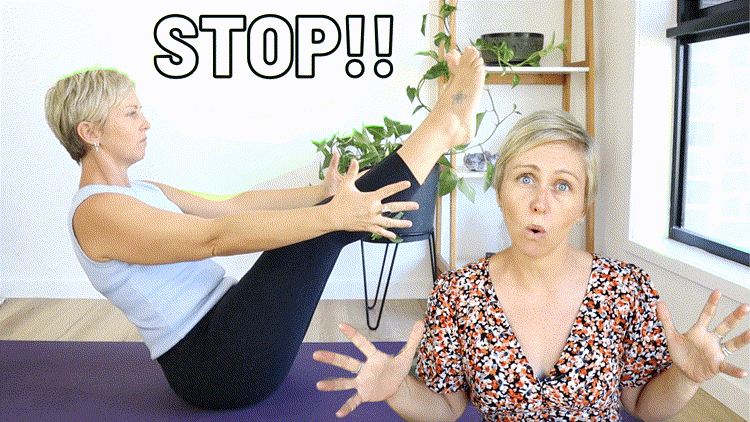Yoga is a beneficial practice for the body and mind, but like any physical activity, there are times when it’s important to pause or adjust your practice.
Knowing when to stop or take a break ensures your safety, promotes recovery, and allows you to practice yoga mindfully and effectively.

Here’s a detailed guide on when to stop yoga and how to approach those situations.
1. When You Experience Pain
Why Stop?
Pain is your body’s way of signaling something is wrong. While discomfort during a stretch is normal, sharp or persistent pain is not. Ignoring pain can lead to injuries such as muscle strains or joint damage.
What to Do Instead?
- Stop the pose immediately and assess the discomfort.
- Modify the pose or use props to reduce strain.
- Consult with a yoga instructor to ensure proper alignment.
2. When You Feel Exhausted or Overwhelmed
Why Stop?
Yoga is meant to rejuvenate, not deplete your energy. If you feel physically or mentally drained, it’s better to pause.
Overexertion can lead to fatigue, reduced focus, and poor form, increasing the risk of injury.
What to Do Instead?
- Shift to restorative poses like Child’s Pose or Savasana.
- Reduce the intensity of your practice or shorten its duration.
- Focus on gentle breathing exercises (Pranayama) to relax your body and mind.
3. When You’re Recovering from an Injury
Why Stop?
Practicing yoga with an injury can delay recovery or worsen the condition. Certain poses may place strain on injured areas, hindering healing.
What to Do Instead?
- Consult a healthcare professional before resuming yoga.
- Explore gentle, injury-appropriate modifications.
- Focus on non-physical aspects of yoga, like meditation or breathing.
4. When You’re Pregnant Without Guidance
Why Stop?
While yoga is generally safe and beneficial during pregnancy, certain poses can be unsafe without proper guidance. Deep twists, backbends, and inversions may harm the baby or cause discomfort.
What to Do Instead?
- Join a prenatal yoga class with an experienced instructor.
- Avoid poses that involve lying on your back or compressing the abdomen.
- Focus on poses that promote relaxation and strengthen the pelvic area.
5. When You’re Feeling Sick
Why Stop?
Your body needs rest to recover from illness. Practicing yoga when you’re unwell can strain your immune system and delay recovery.
What to Do Instead?
- Opt for light breathing exercises or guided meditations if you feel up to it.
- Resume your practice once you’re fully recovered and energized.
6. When You’re Dizzy or Lightheaded
Why Stop?
Dizziness can indicate dehydration, low blood sugar, or overexertion. Pushing through can lead to loss of balance and potential falls.
What to Do Instead?
- Pause and hydrate.
- Sit or lie down until the dizziness subsides.
- Avoid poses that require balance or rapid transitions.
7. When Yoga Causes More Stress Than Relaxation
Why Stop?
Yoga should reduce stress, not add to it. If you feel frustrated by a pose or overwhelmed by the practice, it’s a sign to step back.
What to Do Instead?
- Practice simpler poses or focus on restorative yoga.
- Incorporate mindfulness or meditation to recenter yourself.
- Remember, yoga is about progress, not perfection.
8. During Certain Life Situations
Why Stop?
Major life events like grief, emotional trauma, or extreme fatigue may make physical yoga practice feel overwhelming.
What to Do Instead?
- Explore meditative or mindfulness-based yoga practices.
- Focus on breathing exercises to manage emotions and promote healing.
Signs It’s Time to Take a Break
- Persistent pain or discomfort.
- Fatigue or lack of energy.
- Difficulty concentrating or maintaining balance.
- Emotional stress or frustration.
- Physical conditions that hinder safe movement.
How to Resume Yoga Safely
Listen to Your Body:
- Start with gentle poses and gradually increase intensity.
- Avoid poses that caused discomfort previously.
Seek Professional Guidance:
- Work with a qualified yoga instructor to ensure proper alignment and modifications.
Incorporate Restorative Practices:
- Begin with restorative yoga or light stretching to ease back into your routine.
Focus on Breathwork:
- Breathing exercises like Nadi Shodhana (alternate nostril breathing) can help you reconnect with your practice.
Conclusion
Knowing when to stop yoga is just as important as knowing when to start. By listening to your body and respecting its needs, you can ensure a safe and enjoyable practice.
Remember, yoga is not about pushing through discomfort but about creating a harmonious connection between your mind, body, and spirit.
Take breaks when needed, and return to your practice when you feel ready, stronger, and more balanced.



